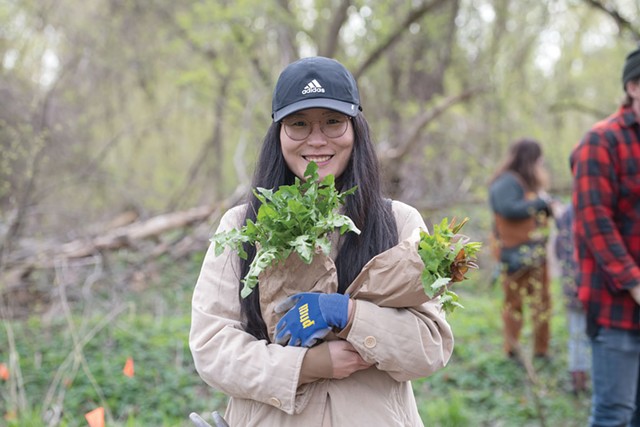
- Daria Bishop
- Menghan Wang of Montpelier showing her freshly foraged bounty
A late April nature walk in Burlington's Intervale started out unexpectedly high-tech. As the 18 participants gathered, Duncan Murdoch, the Intervale Center's natural areas stewardship coordinator, asked them to scan a QR code with their phones. Everyone stared at their screens for a few minutes reading the Intervale Center's ethical foragers pledge.
The pledge states that "foraging for highly nutritious food and medicine is encouraged" on the roughly 350 acres of floodplain land managed by the nonprofit. "But," it continues, "we ask of you to be thoughtful about how we 'take' what the land has to offer so that we don't deplete and destroy the species that make up our beautiful natural community."
Specifically, the pledge sets guidelines for Vermont's most prized early spring edibles: oniony ramps, also called wild leeks, and the furled fiddleheads of the ostrich fern. It asks visitors not to gather ramps, which have largely disappeared from the area likely due to overharvesting, and encourages limited fiddlehead collection only outside signed restoration areas.
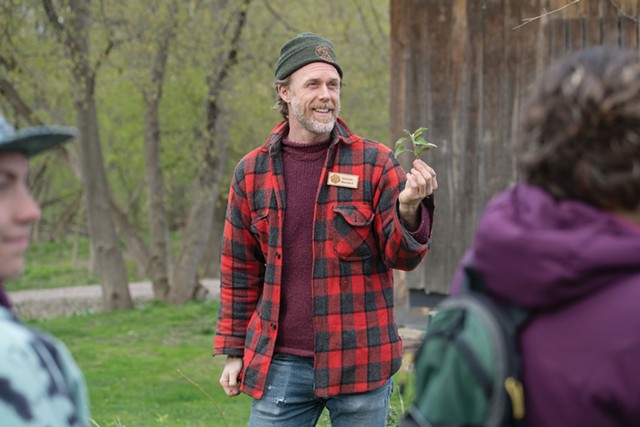
- Daria Bishop
- Duncan Murdoch
The preamble did not surprise attendees of the Sustainable Foraging Walk offered through City Market, Onion River Co-op's community programming. It was the explicit draw for Sienna DeVoe-Talluto of Shelburne, who said she was equally interested in learning how to identify edible species and "how we can interact with plants sustainably."
During the 90-minute walk, Murdoch easily demonstrated that there remains a cornucopia of edibles to gather — and that early spring, when plants are young and tender, is prime season.
After a brief stop to nibble on the tips of hostas that had been planted near the nonprofit's farmhouse headquarters, Murdoch carefully dug a full dandelion rosette and root from the grass. Now is the perfect time, he said, to eat dandelion greens, which get more bitter as the weather warms. Their roots, he added, make a nice tea.
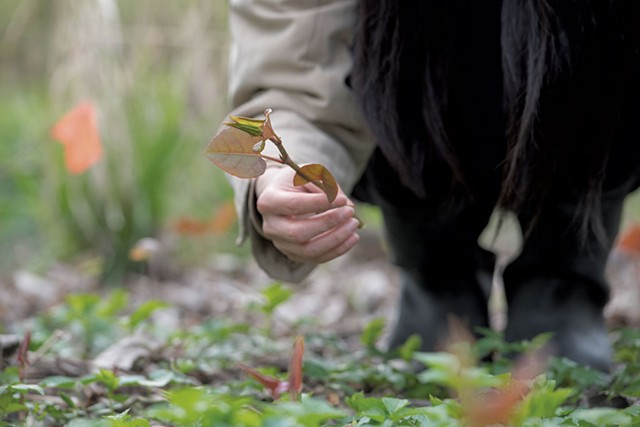
- Daria Bishop
- Japanese knotweed (inset)
When foraging edible and medicinal plants, Murdoch advised, the general rule is: "Don't take a whole lot, and leave a bunch." He did share several exceptions to that rule, especially for non-native, invasive plants, such as garlic mustard and Japanese knotweed.
Stinging nettles, Murdoch said, are native but prolific and can generally be harvested liberally, too. He demonstrated how he pinches off the tips, leaving the rest of the plant to grow. Use gloves, he cautioned, and always cook the greens to remove the sting.
The walk was well-timed to harvest scalloped leaves of garlic mustard before it flowers and spreads seed. Murdoch likes to sauté the young greens with garlic and butter. "Please take as much as you want," he urged.
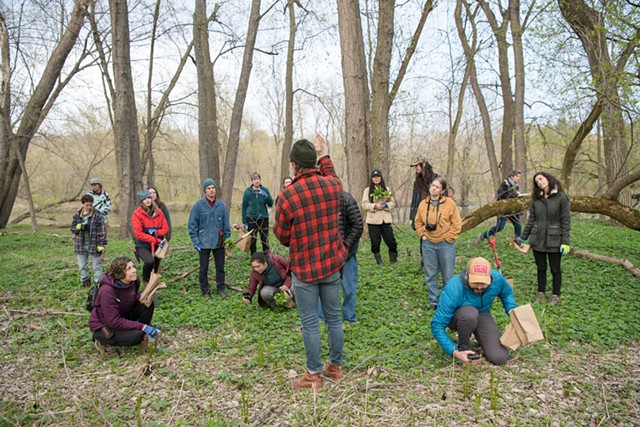
- Daria Bishop
- Duncan Murdoch (center) leading a foraging walk
Murdoch also pointed out delicate violet flowers, which make a "gorgeous" tea; dug up burdock root, which can be used for tea or eaten stir-fried; and picked a red-speckled Japanese knotweed shoot, which he described as reminiscent of rhubarb. "What strikes me is how much food is here in the wild," he said.
After sampling knotweed, Miranda and Joey Chase of Shelburne had different reactions. "It tastes like sour candy. I want more of it," Miranda said. Joey remained dubious, influenced by "three years digging it out of my parents' yard."
Hyla Howe of Essex Junction observed that our food choices have significant environmental impact. "Instead of buying spinach, you could just eat garlic mustard," she said. "It'll cut down on fossil fuels and get rid of invasives."

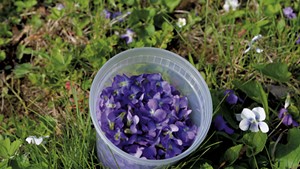
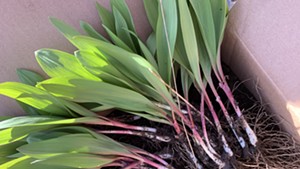










Comments
Comments are closed.
From 2014-2020, Seven Days allowed readers to comment on all stories posted on our website. While we've appreciated the suggestions and insights, right now Seven Days is prioritizing our core mission — producing high-quality, responsible local journalism — over moderating online debates between readers.
To criticize, correct or praise our reporting, please send us a letter to the editor or send us a tip. We’ll check it out and report the results.
Online comments may return when we have better tech tools for managing them. Thanks for reading.